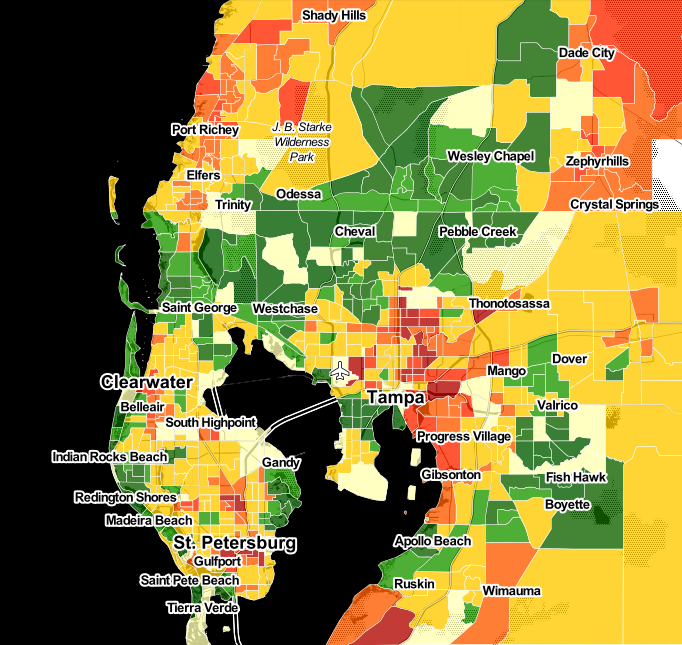Investors are buying homes in Tampa at a record rate. Between July and September 2021, one in four homes that sold had an investor as the buyer. According to a report from the Tampa Bay Times, Tampa Bay ranks as the 7th hottest metro area for investors nationwide.
The rising price of homes in Tampa and across the state are pushing potential buyers into the rental market. Florida has seen average rents skyrocket by 30%, which is the largest spike in the country.
There’s steady job growth being created by higher-paying professional and business services. In turn, these business expansions are spurring economic growth in Tampa. The result is that there’s a rapidly rising demand for housing in Tampa and Hillsborough County, where Tampa is located.
Plus, Tampa is simply a great place to live and do business. Located in western Florida along Tampa Bay and near the Gulf of Mexico, the Tampa Bay Area is generating jobs and population growth that leaves most other cities in the country green with envy.
The economy is founded on a diverse economic base including finance, technology, tourism, and construction, and the Port of Tampa is the largest in Florida. The rental market is strong, and numerous publications rank Tampa as one of the best places to be in the U.S.
Keep reading to learn why you should consider the Tampa real estate market in 2022.
>>Explore Roofstock's Tampa properties here.
Population growth
The population of Tampa (including Hillsborough County) has seen a net population gain of over 230,000 new residents over the last ten years, based on statistics from the U.S. Census Bureau. The most recent population growth report shows that more people are coming to the Tampa Bay metro area than Miami, Fort Lauderdale, or Palm Beach.
Key population stats:
- Tampa is the 3rd most populous city in Florida, after Miami and Jacksonville, and the 52nd most populous city in the U.S.
- Tampa MSA consists of Tampa, St. Petersburg, and Clearwater.
- Nearly 385,000 people live in the City of Tampa and there are nearly 3.1 million residents in the Tampa Bay/Hillsborough County metropolitan area.
- Population growth in Tampa was 1.3% last year and is projected to grow 3.3% annually over the next few years.
- More than 126,000 new residents are forecast to move to the metropolitan area by 2024.
- Population growth in the Tampa MSA is expected to be 25% over the next 20 years, with more than 3.8 million people living in the metropolitan area by 2040.
Job market
The Tampa area gained the most private sector jobs of all metro areas in the state (as of September 2021), adding 84,600 new jobs since the beginning of 2021. As the economy continues to recover, key employment sectors such as leisure and hospitality, construction, professional and business services, and financial services are all showing positive job growth.
Key employment stats:
- GDP of the Tampa MSA is more than $169 billion, according to the Federal Reserve Bank of St. Louis, and has grown by nearly 46% over the last 10 years.
- Employment growth in Tampa was 3.3% over the past 12 months, while the unemployment rate is down to 2.3%.
- Expansions and recovery in the business services, tourism, and healthcare industries are projected to drive the growth of the job market in Tampa.
- High-growth industries in the Tampa metro area include financial and professional services, information technology, life sciences and healthcare, manufacturing, and distribution and logistics.
- Twenty companies with a combined annual revenue of more than $1 billion have their corporate headquarters in Tampa Bay, including eight Fortune 1000 companies.
- Largest employers in Tampa Bay include Publix Super Markets Inc., BayCare Health Care Systems, Walmart, Verizon Communications, TECO Energy Inc., MacDill Air Force Base, Times Publishing Co., and OSI Restaurant Partners LLC (casual dining company operator of Outback Steakhouse, Carrabba’s Italian Grill, and Flemings Steakhouse).
- University of South Florida, University of Tampa, Hillsborough Community College, and Stetson College of Law are some of the biggest institutions of higher education in Tampa.
- 89.9% of the people in Tampa are high school graduates or higher, while 31.2% hold a bachelor’s degree or advanced degree.
- Interstate highways I-4, I-75, and I-275 pass through Tampa and provide access to 34 million consumers within an 8-hour drive.
- Port of Tampa Bay is the largest seaport in Florida, providing service to both cargo shippers and cruise lines.
- Tampa International Airport, St. Petersburg-Clearwater International Airport, and Sarasota-Bradenton International Airport are all located within the Tampa metropolitan area and provide non-stop service to more than 90 domestic and international destinations.
Real estate market
The housing market in Tampa-St. Petersburg-Clearwater is forecast to be one of the top housing markets for 2022. According to Realtor.com, home sales are expected to surge by 9.6% while prices are projected to rise by 6.8% year-over-year.
Key market stats:
- Typical value of a home in Tampa is $398,384, according to the Zillow Home Value Index (as of April 2022).
- Home values in Tampa increased by 34.9% last year.
- Median listing price of a house in Tampa is $405,300 based on the most recent report from Realtor.com (April 2022).
- Square foot listing price of a home in Tampa is $260.
- Median sold price of a home in Tampa is $389,000.
- Days on market (median) is 40.
- Sale-to-list price ratio is 101.54%, meaning most of the homes sell for slightly above the asking price on average.
- Of the 93 neighborhoods in Tampa, Sunset Park is the most expensive with the median listing price of $2.7M for a house while Sulphur Springs is the most affordable neighborhood with a median listing price of $237,000.

Attractive renters’ market
The hot housing market is leaving some buyers out in the cold, helping to drive the demand for rental property in the Tampa metropolitan area. As the Tampa Bay Times reports, pent-up demand and low inventory is making it difficult for first-time home buyers to compete.
The rental market in Tampa is also attracting the attention of institutional investors. For example, Invitation Homes is estimated to own and rent more than 8,000 single-family houses in the metropolitan area.
Key market stats:
- Median rent in Tampa is $2,300 per month for a 3-bedroom home, according to Zumper (as of June 2022).
- Rents in Tampa increased by 16% last year.
- 48% of the households in Tampa rent rather than own.
- Most affordable neighborhoods for renters in Tampa are East Side Commercial Area, Northview Hills, and Woodland Terrace where rents range between $795 and $1,050 per month.
- Most expensive neighborhoods for renters include Historic Hyde Park North, Bayshore Beautiful, and Ballast Point where rents can go as high as $5,500 per month.
- Three of the most popular neighborhoods for renters in the Tampa metro area are Sun Bay South, Downtown Tampa, and Harbour Island.
Historic price changes & housing affordability
Reviewing the historic price changes and the affordability of housing in a market are two processes real estate investors use to anticipate the future demand for rental property in a specific area.
Every month, Freddie Mac publishes the Freddie Mac House Price Index (FMHPI) report that updates the short- and long-term trends of home prices in all major markets in the U.S.
The most recent FMHPI on the Tampa metro area from Freddie shows that:
- April 2017 HPI: 193.06
- April 2022 HPI: 380.96
- 5-year change in home prices: 97.3%
- One-year change in home prices: 32.8%
- Monthly change in home prices: 2.7%
Real estate investors in Tampa also research housing affordability to help forecast the current and future demand for rental real estate. Affordability compares the amount of annual income needed to purchase a median-priced home in Tampa.
Business forecast and personal finance publication Kiplinger publishes a housing affordability report for the top 100 metropolitan areas in the U.S. The firm ranks affordability on a scale of 1 to 10, with 1 representing the most affordable markets and 10 the least affordable.
Kiplinger’s analysis of housing affordability in Tampa reports:
- Since the last real estate cycle market peak in May 2006, home prices in Tampa have declined by 3.7%.
- Since the last real estate cycle market bottom in March 2012, home prices in Tampa have increased by 105.7%.
- Tampa has an affordability index of 5 out of 10, meaning that housing affordability in the market is mid-range and helps to explain the percentage of people renting in Tampa.
Quality of life
About two years ago, Livability.com asked why everyone seems to be moving to Tampa. Fast forward to today, and the answer remains the same. Job opportunities, near perfect weather, and reinvention of the urban core and waterfront areas as a few of the countless reasons why the quality of life in Tampa is attracting more people, businesses, and rental property investors.
Key quality of life stats:
- Cost of living index from the Tampa Bay Economic Development Council reports that it is cheaper to live in Tampa than many other large metro areas such as Atlanta, Denver, Phoenix, Orlando, and Nashville.
- Forbes ranks Tampa as among the best places for business and careers and job growth.
- Tampa receives high ratings from U.S. News & World Report for overall desirability, value, job market, and quality of life.
- Niche.com gives the Tampa metro area an “A” grade for nightlife, weather, and outdoor activities.
- Water Street Tampa is a $3 billion mixed-use development project that has transformed the Downtown Waterfront into a vibrant place to live, work, and play.
- The Florida Aquarium, Tampa Museum of Art, and Sparkman Wharf are some of the best entertainment venues in Tampa Bay.
- Pro sports teams in Tampa include the NFL Tampa Bay Buccaneers, MLB Tampa Bay Rays, and the NHL Tampa Bay Lightning.
Get out the map
Where to begin your search? Roofstock created a heat map of Tampa based on our Neighborhood Rating, a dynamic algorithm that enables you to make informed investment decisions by measuring school district quality, home values, employment rates, income levels and other vital investment criteria.

DARK GREEN: 4-5 star neighborhood
LIGHT GREEN: 3.5-4 star neighborhood
YELLOW: 2.5-3 star neighborhood
ORANGE: 2 star neighborhood
RED: 1 star neighborhood
Ready to invest in the Tampa housing market? If you haven't already done so, create your free Roofstock account and set up alerts. We'll notify you when we have a Tampa investment property that matches your search criteria.









